Home / Wittig Reaction
Aldehydes and Ketones
Wittig Reaction
Last updated: February 12th, 2025 |
The Wittig Reaction: A Useful Method For Converting Aldehydes and Ketones To Alkenes
Some time ago, we learned how to turn alkenes into carbonyls via ozonolysis.
But we haven’t yet learned how to go in the opposite direction – from carbonyls to alkenes.
It’s useful to think of functional groups like airports, and reactions as being like flights between cities. In any reaction map you care to draw, carbonyls and alkenes are big hubs. So only knowing how to go from carbonyls to alkenes is a bit like being able to book a one-way flight from New York to Chicago… but not a return!
Let’s address this important gap in our synthetic toolbox.
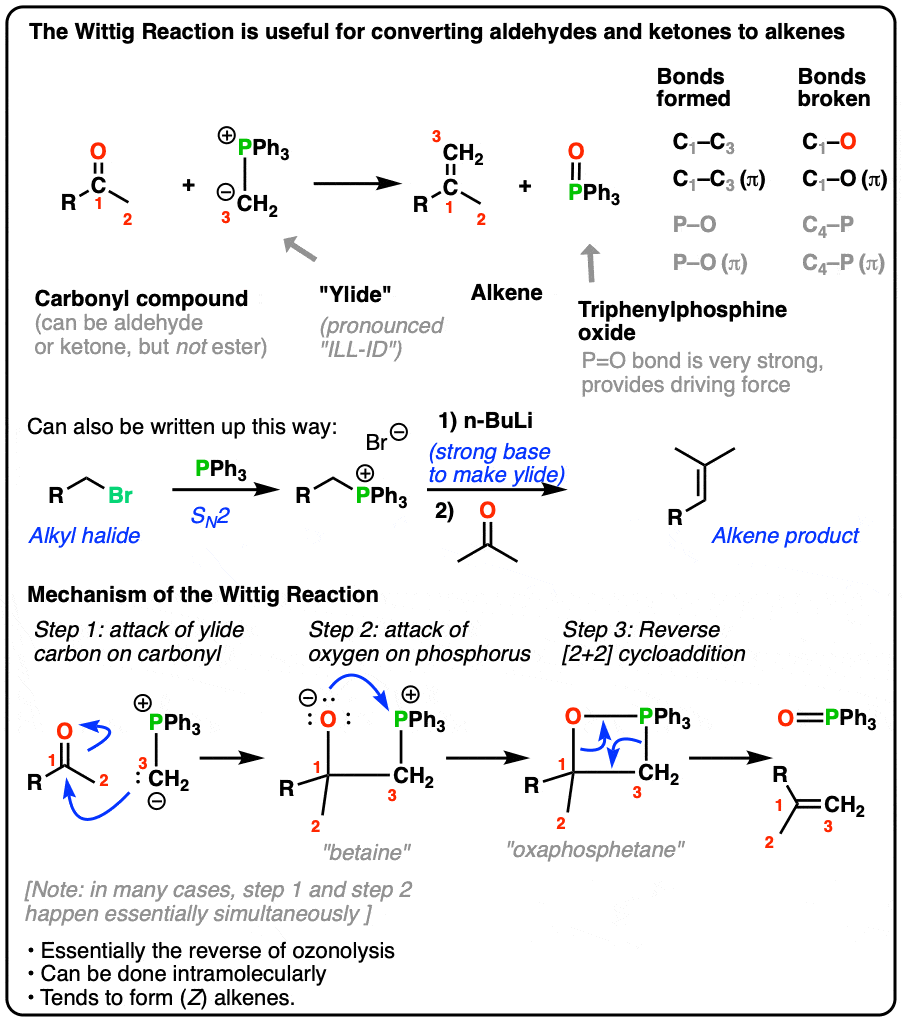
Table of Contents
- The Wittig Reaction
- The Mechanism of the Wittig Reaction
- How Are Ylides Made? A Quick Primer
- Some Examples Of The Wittig Reaction
- Summary: The Wittig Reaction
- (Advanced) When Stereochemistry Rears Its Ugly Head
- Notes
- Quiz Yourself!
- References And Further Reading
1. The Wittig Reaction
Below is a useful reaction called the Wittig reaction that achieves this transformation. It won its inventor, Georg Wittig, the 1979 Nobel Prize in Chemistry (along with the father of hydroboration, H.C. Brown).
The two components of this reaction are:
- a carbonyl compound (aldehydes and ketones both work, but not esters or amides)
- a rather strange-looking species known as an ylide. (specifically, a “phosphonium ylide”, because there are also ylides of nitrogen and sulfur).
The technical definition of an ylide is a species with opposite formal charges on adjacent atoms. Although we drew the ylide, above, with a double bond between C and P, it also has an important resonance form with a positive charge on phosphorus and a negative charge on carbon:
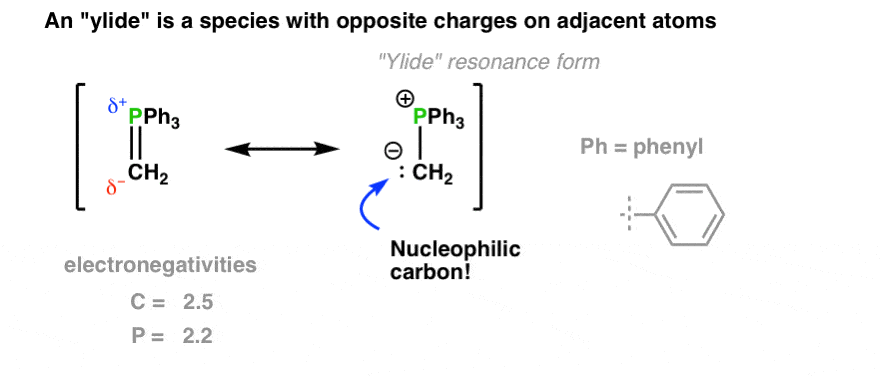
The carbon of this ylide therefore behaves in many ways as a carbanion, and can readily act as a nucleophile.
2. The Mechanism of the Wittig Reaction
If you look above to the bonds that form and break in the Wittig reaction, you’ll see that it essentially swaps C=P and C=O bonds for C=C and O=P bonds.
So how does it work?
The version of events described in most introductory textbooks follows below. [ Note 1, describes a slightly modified account of the mechanism that is generally more accurate. ]
We’ve already seen many examples of how carbonyl carbons are excellent electrophiles. reacting with nucleophiles such as Grignard reagents, metal hydrides, organolithiums and many other species. [e.g. The Simple 2-Step Pattern For 7 Reactions of Aldehydes and Ketones]
So one can imagine the first step of the Wittig reaction as being the attack of the nucleophilic ylide carbon on the electrophilic carbonyl carbon, providing a species with a negative charge on oxygen and a positive charge on phosphorus. This is the classic “addition” (sometimes called “1,2-addition”) mechanism to carbonyls.
The second step of the Wittig, then, is the attack of the resulting oxygen at phosphorus, giving a 4-membered ring. [Cocktail-party worthy fun fact: this is called an oxaphosphetane ]
The 4-membered ring is very short-lived and quickly breaks down, via a process called a reverse [2+2] cycloaddition, to give the final products: a phosphine oxide (“triphenylphosphine oxide” in this case), and the new alkene.
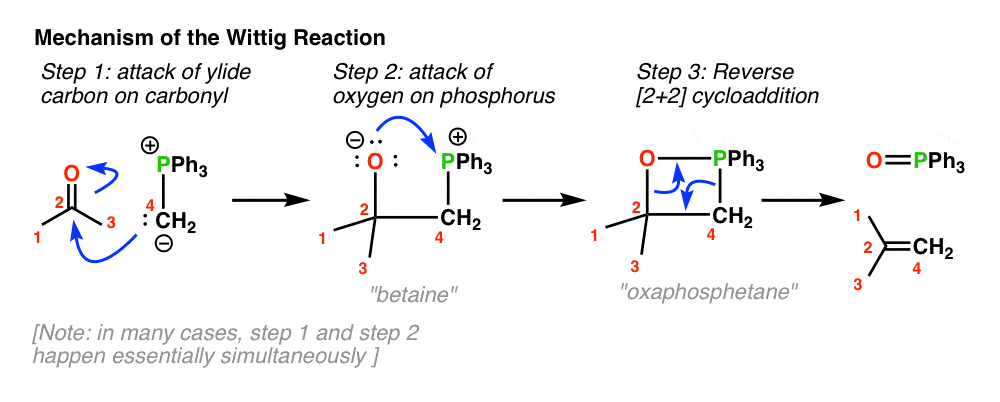
[In many cases, step 1 and step 2 essentially happen simultaneously, but this mechanism is fine for our purposes. ]
Although the example above is fairly simple, the Wittig reaction can be readily extended to more complex reaction partners, as we’ll see below. Before we dive into that, though, it might be worth a few moments for a brief digression.
3. How Are Ylides Made? A Quick Primer
Ylides might look a little exotic, but their synthesis is actually quite straightforward and involves no unfamiliar chemistry. They are usually made through just two familiar reactions: nucleophilic substitution reaction (SN2) followed by an acid-base reaction.
We start by treating an alkyl halide (another functional group “hub” in our airport analogy) with the excellent nucleophile triphenylphosphine (PPh3), which displaces the leaving group (via SN2) to give a phosphonium salt.
[When planning a Wittig, it’s generally best to use a primary alkyl halide (or alkyl sulfonate) here, as secondary alkyl halides don’t work as well. ]
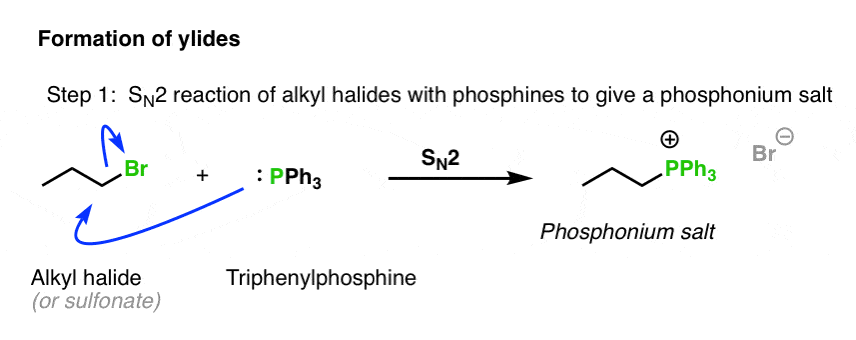
The C-H bond adjacent to the phosphorus is relatively acidic [Note 2] and can be deprotonated with strong base to give the ylide shown. A common base to use is the readily available n-butyllithium (n-BuLi ). Sodium amide (NaNH2) can also be used.
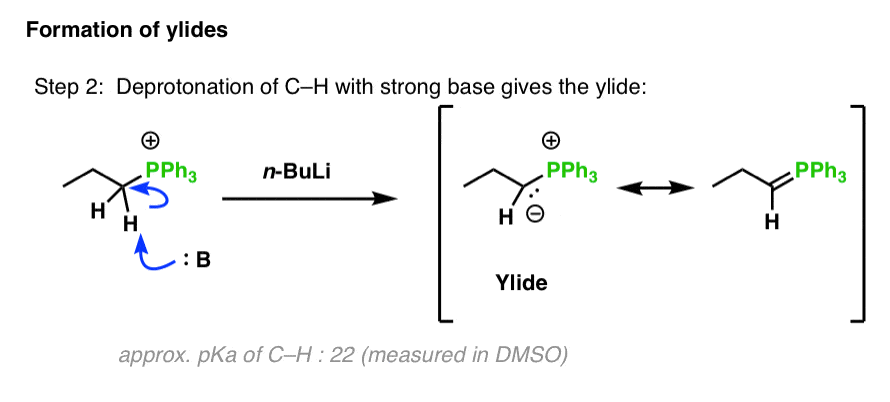
[Note 3 on the pKa of the C-H bond]
The resulting ylide is then ready to go. No need to isolate it – just add an aldehyde or ketone, and the reaction should proceed nicely.
4. Some Examples Of The Wittig Reaction
For example, here’s the above ylide in a Wittig reaction with cyclohexanone:

The Wittig can be used to convert a wide variety of ketones and aldehydes to alkenes.
To see more examples, hover here or click this link.
It can even be used to form rings. Here, we form a double bond between C-1 and C-6:

To see the mechanism of this reaction drawn out, hover here for a pop-up image or open an image link here .
5. Summary: The Wittig Reaction
In summary, the Wittig is a very important reaction for several reasons:
- it’s a carbon-carbon bond forming reaction, which allows for extension of the carbon chain
- the components (carbonyls and ylides) are readily available and/or easily synthesized from readily available precursors
- the resulting alkenes can be further transformed into a large variety of functional groups – too many to list here, but for some inspiration, check out this reaction map of alkenes.
Here’s a quick example in synthesis: extending the carbon chain and incorporating an alcohol at the end, via hydroboration.

For many students, that’s all you need to know about the Wittig for now. For those insatiably curious about what can go wrong when we move beyond some simple examples… read on.
6. (Advanced) When Stereochemistry Rears Its Ugly Head
The examples above rigorously avoided any situation where a mixture of E and Z alkenes could be obtained.
What happens when we try to combine an aldehyde (or unsymmetrical ketone) with an unsymmetrical ylide?
We won’t wade too deeply into the topic of stereochemistry here, but for your average aldehyde reacting with your average ylide prepared by the methods above, the major alkene stereoisomer tends to be Z. [Note 4]
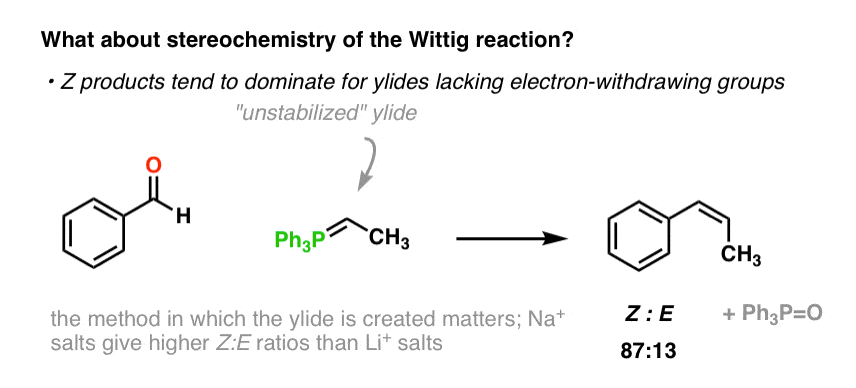
The ratio of the Z isomer decreases as electron-withdrawing groups are added to the ylide. These species are called, “stabilized ylides”, as they are less basic (and less reactive).

This is simple enough and probably enough for most purposes. We don’t have time here to get into the excellent Horner-Emmons-Wadsworth reaction, which bears many similarities to the Wittig, and provides excellent E:Z selectivity.
For an excellent set of notes on some of the more advanced facets of the Wittig and related reactions, see these handouts from Andrew Myers’ advanced organic chemistry course (CHEM 215) at Harvard.
Notes
Related Articles
Note 1. We’ve shown the mechanism occurring in a stepwise process, but a detailed study of the Wittig mechanism [see here] strongly suggests that it mainly through a [2+2] cycloaddition followed by a reverse [2+2] cycloaddition.
That is not nearly as complicated as it sounds. Following the central figures in this square dance will give you the main idea:
[adapted from the original on youtube: also invoked to to explain the Chauvin mechanism of olefin metathesis]
Here’s what it looks like. Note that instead of an initial addition step (leading to a betaine intermediate), the four-membered ring is just formed directly. The second step (reverse [2+2] cycloaddition) is the same.
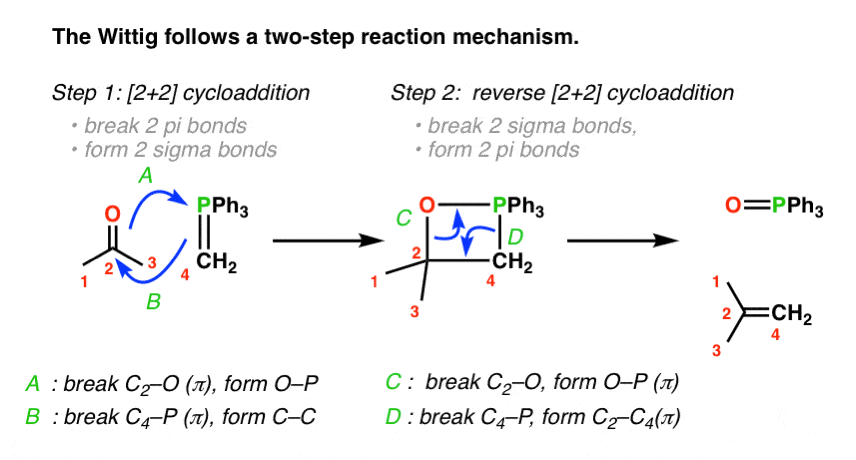
Note 2. Called a “betaine”.
Note 3. The Evans pKa table gives a pKa for Ph3P–CH3 of 22 (in DMSO), making it more acidic than a terminal alkyne. Note that PPh3 is a good choice because it doesn’t have any potentially acidic carbons adjacent to the phosphorus. If we used P(CH3)3 as the nucleophile, for example, then using n-BuLi could lead to a mixture of of ylides in many cases. We don’t want that! [Nor, for most purposes, do we want P(CH3)3, which is among the more foul-smelling and toxic liquids you will ever encounter in a chemistry lab, but I digress…. ]
Note 4. Very interesting to note that the identity of the base matters greatly: using a lithium base, such as n-BuLi, (and added lithium iodide) results in a mixture of products with a Z:E ratio of 58:42 , whereas sodium bases give more of the Z. In the presence of added lithium salts, it’s likely true that a betaine intermediate is present, and there is more equilibration between the starting materials and the intermediate oxaphosphetane.
Quiz Yourself!
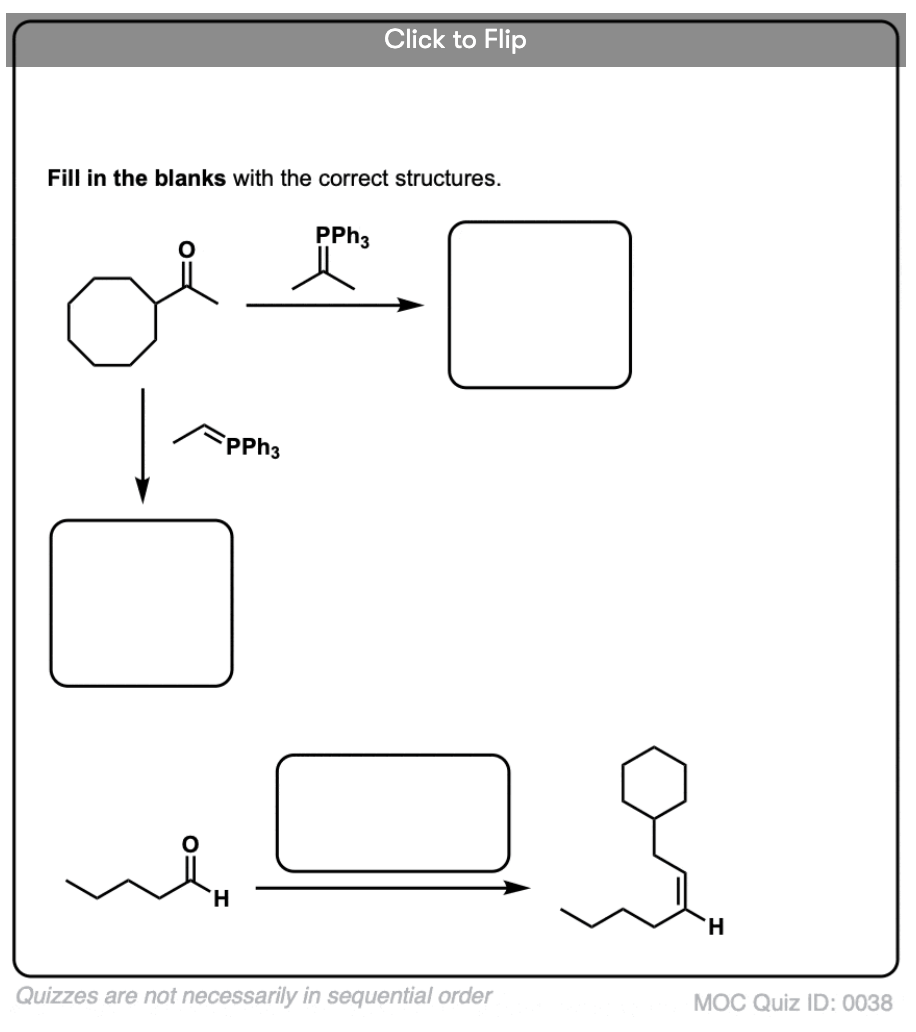
Become a MOC member to see the clickable quiz with answers on the back.
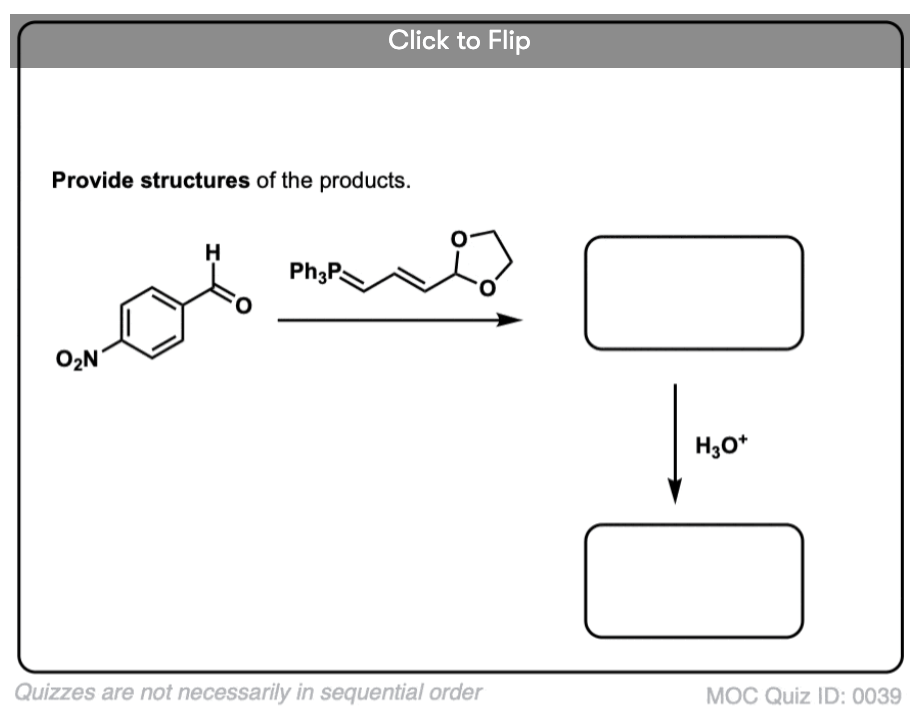
Become a MOC member to see the clickable quiz with answers on the back.
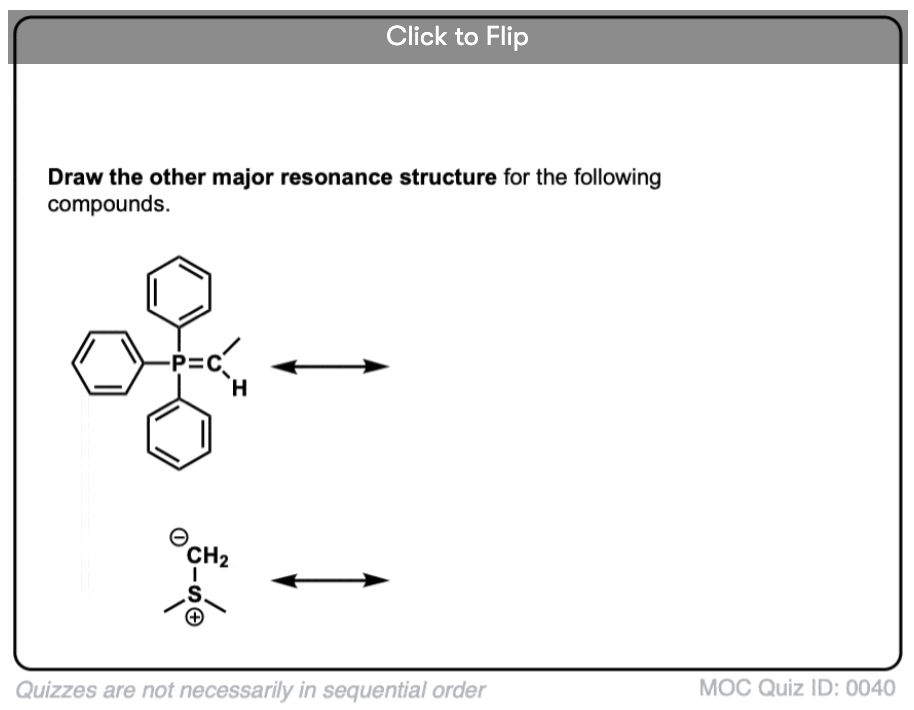
Become a MOC member to see the clickable quiz with answers on the back.
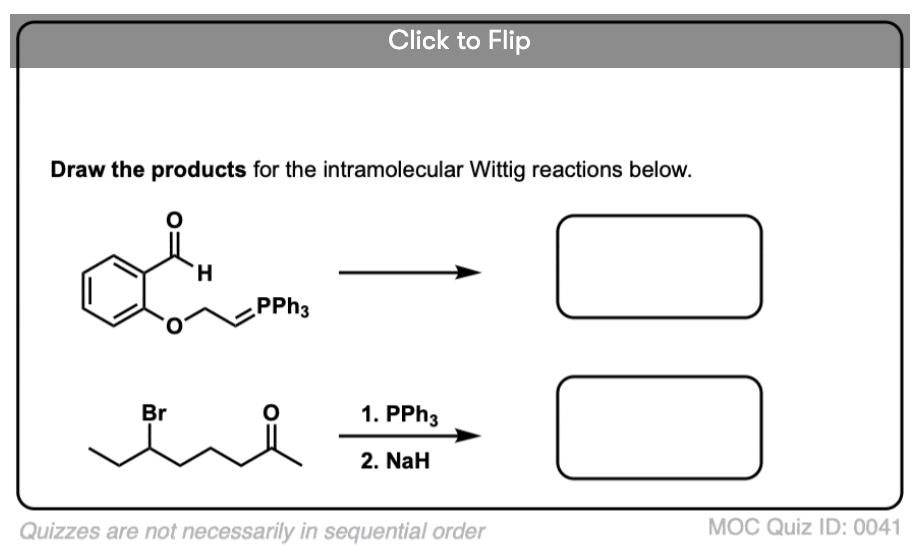
Become a MOC member to see the clickable quiz with answers on the back.
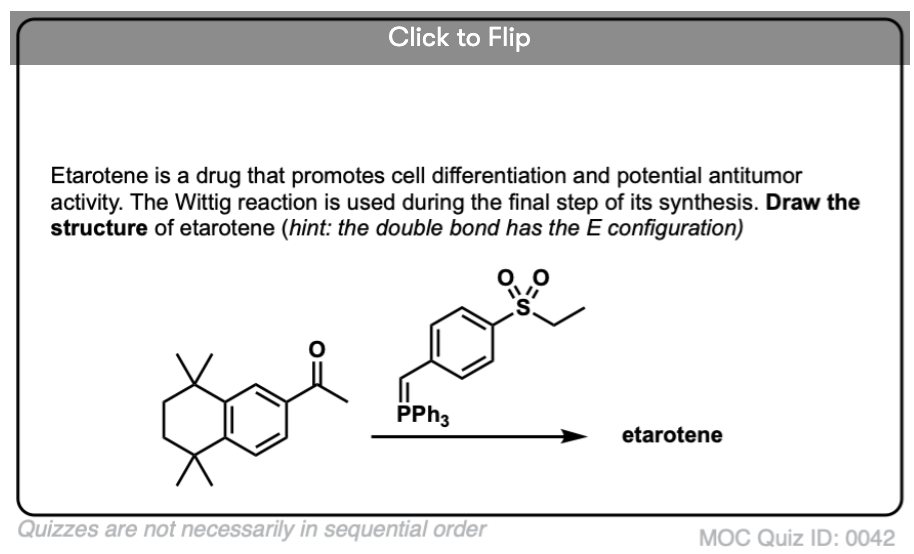
Become a MOC member to see the clickable quiz with answers on the back.
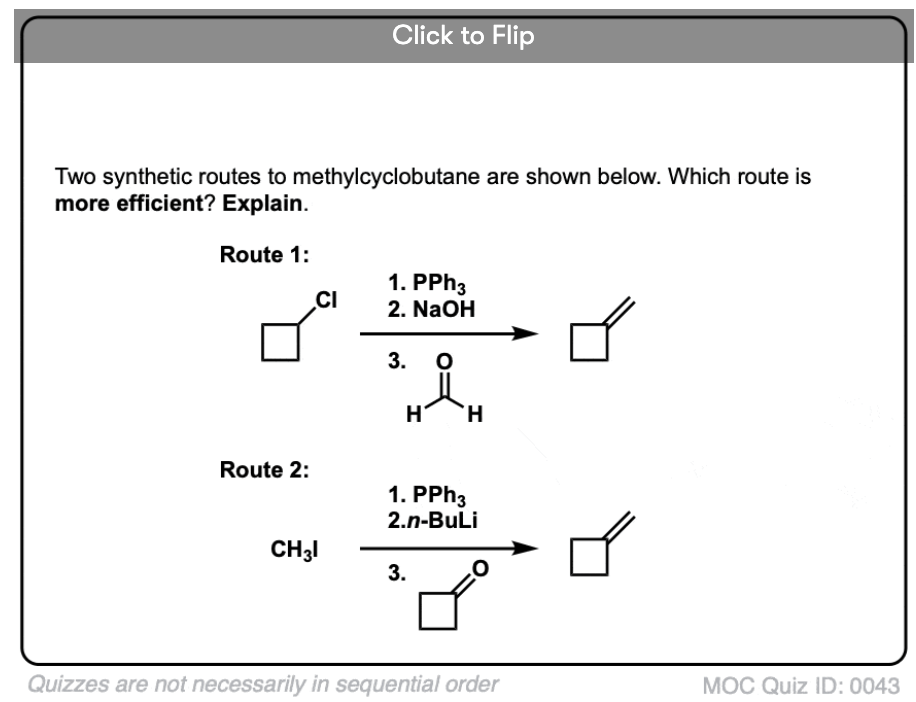
Become a MOC member to see the clickable quiz with answers on the back.
(Advanced) References And Further Reading
- Useful (advanced) overview to the Wittig: see Prof. Andrew Myers’ 115 Notes (Harvard).
- Über Triphenyl‐phosphin‐methylene als olefinbildende Reagenzien (I. Mitteil.
Georg Wittig, Ulrich Schöllkopf Ber. 1954 87 (9), 13318
DOI: 10.1002/cber.19540870919 - Über Triphenyl‐phosphinmethylene als olefinbildende Reagenzien (II. Mitteil.1))
Georg Wittig, Werner Haag Ber.1955, 88 (11), 1654
DOI: 10.1002/cber.19550881110
The first two papers by Nobel Laureate Prof. Georg Wittig on a new olefination reaction based on phosphonium ylides. - From Diyls to Ylides to My Idyll
Georg Wittig Science 1980, 210 (4470), 600
DOI: 1126/science.210.4470.600
Prof. Wittig’s Nobel Lecture, in which he talks about how he first discovered phosphonium ylides on accident while trying to synthesize pentavalent nitrogen compounds, as well as the origin of the term ‘ylide’. - METHYLENECYCLOHEXANE
George Wittig and U. Schoellkopf
Org. Synth. 1960, 40, 66
DOI: 10.15227/orgsyn.040.0066
Reproducible and tested procedure for methylidenation with phosphonium ylides reported by Nobel Laureate Prof. G. Wittig. - Unusual solvent effects in the Wittig reaction of some ketones indicating initial one-electron transfer
George A. Olah and V. V. Krishnamurthy
Journal of the American Chemical Society 1982, 104 (14), 3987-3990
DOI: 1021/ja00378a035
This paper, unusually from Nobel Laureate Prof. George Olah, shows that single-electron transfer reduction can take place when reacting sterically hindered ketones (e.g. 2-adamantanone) with bulky phosphonium ylides. - Reactivity and Selectivity in the Wittig Reaction: A Computational Study
Raphaël Robiette, Jeffery Richardson, Varinder K. Aggarwal, and, and Jeremy N. Harvey
Journal of the American Chemical Society 2006 128 (7), 2394-2409
DOI: 1021/ja056650q
A computational investigation of the Wittig reaction that attempts to explain the stereochemistry of the products (unstabilized ylides yield Z-alkenes and stabilized ylides give E-alkenes). - Acidity of phosphonium ylides.
Xian Man Zhang, and Frederick G. Bordwell
00 General Chemistry Review
01 Bonding, Structure, and Resonance
- How Do We Know Methane (CH4) Is Tetrahedral?
- Hybrid Orbitals and Hybridization
- How To Determine Hybridization: A Shortcut
- Orbital Hybridization And Bond Strengths
- Sigma bonds come in six varieties: Pi bonds come in one
- A Key Skill: How to Calculate Formal Charge
- The Four Intermolecular Forces and How They Affect Boiling Points
- 3 Trends That Affect Boiling Points
- How To Use Electronegativity To Determine Electron Density (and why NOT to trust formal charge)
- Introduction to Resonance
- How To Use Curved Arrows To Interchange Resonance Forms
- Evaluating Resonance Forms (1) - The Rule of Least Charges
- How To Find The Best Resonance Structure By Applying Electronegativity
- Evaluating Resonance Structures With Negative Charges
- Evaluating Resonance Structures With Positive Charge
- Exploring Resonance: Pi-Donation
- Exploring Resonance: Pi-acceptors
- In Summary: Evaluating Resonance Structures
- Drawing Resonance Structures: 3 Common Mistakes To Avoid
- How to apply electronegativity and resonance to understand reactivity
- Bond Hybridization Practice
- Structure and Bonding Practice Quizzes
- Resonance Structures Practice
02 Acid Base Reactions
- Introduction to Acid-Base Reactions
- Acid Base Reactions In Organic Chemistry
- The Stronger The Acid, The Weaker The Conjugate Base
- Walkthrough of Acid-Base Reactions (3) - Acidity Trends
- Five Key Factors That Influence Acidity
- Acid-Base Reactions: Introducing Ka and pKa
- How to Use a pKa Table
- The pKa Table Is Your Friend
- A Handy Rule of Thumb for Acid-Base Reactions
- Acid Base Reactions Are Fast
- pKa Values Span 60 Orders Of Magnitude
- How Protonation and Deprotonation Affect Reactivity
- Acid Base Practice Problems
03 Alkanes and Nomenclature
- Meet the (Most Important) Functional Groups
- Condensed Formulas: Deciphering What the Brackets Mean
- Hidden Hydrogens, Hidden Lone Pairs, Hidden Counterions
- Don't Be Futyl, Learn The Butyls
- Primary, Secondary, Tertiary, Quaternary In Organic Chemistry
- Branching, and Its Affect On Melting and Boiling Points
- The Many, Many Ways of Drawing Butane
- Wedge And Dash Convention For Tetrahedral Carbon
- Common Mistakes in Organic Chemistry: Pentavalent Carbon
- Table of Functional Group Priorities for Nomenclature
- Summary Sheet - Alkane Nomenclature
- Organic Chemistry IUPAC Nomenclature Demystified With A Simple Puzzle Piece Approach
- Boiling Point Quizzes
- Organic Chemistry Nomenclature Quizzes
04 Conformations and Cycloalkanes
- Staggered vs Eclipsed Conformations of Ethane
- Conformational Isomers of Propane
- Newman Projection of Butane (and Gauche Conformation)
- Introduction to Cycloalkanes
- Geometric Isomers In Small Rings: Cis And Trans Cycloalkanes
- Calculation of Ring Strain In Cycloalkanes
- Cycloalkanes - Ring Strain In Cyclopropane And Cyclobutane
- Cyclohexane Conformations
- Cyclohexane Chair Conformation: An Aerial Tour
- How To Draw The Cyclohexane Chair Conformation
- The Cyclohexane Chair Flip
- The Cyclohexane Chair Flip - Energy Diagram
- Substituted Cyclohexanes - Axial vs Equatorial
- Ranking The Bulkiness Of Substituents On Cyclohexanes: "A-Values"
- Cyclohexane Chair Conformation Stability: Which One Is Lower Energy?
- Fused Rings - Cis-Decalin and Trans-Decalin
- Naming Bicyclic Compounds - Fused, Bridged, and Spiro
- Bredt's Rule (And Summary of Cycloalkanes)
- Newman Projection Practice
- Cycloalkanes Practice Problems
05 A Primer On Organic Reactions
- The Most Important Question To Ask When Learning a New Reaction
- Curved Arrows (for reactions)
- Nucleophiles and Electrophiles
- The Three Classes of Nucleophiles
- Nucleophilicity vs. Basicity
- What Makes A Good Nucleophile?
- What Makes A Good Leaving Group?
- 3 Factors That Stabilize Carbocations
- Equilibrium and Energy Relationships
- 7 Factors that stabilize negative charge in organic chemistry
- 7 Factors That Stabilize Positive Charge in Organic Chemistry
- What's a Transition State?
- Hammond's Postulate
- Learning Organic Chemistry Reactions: A Checklist (PDF)
- Introduction to Oxidative Cleavage Reactions
06 Free Radical Reactions
- Bond Dissociation Energies = Homolytic Cleavage
- Free Radical Reactions
- 3 Factors That Stabilize Free Radicals
- What Factors Destabilize Free Radicals?
- Bond Strengths And Radical Stability
- Free Radical Initiation: Why Is "Light" Or "Heat" Required?
- Initiation, Propagation, Termination
- Monochlorination Products Of Propane, Pentane, And Other Alkanes
- Selectivity In Free Radical Reactions
- Selectivity in Free Radical Reactions: Bromination vs. Chlorination
- Halogenation At Tiffany's
- Allylic Bromination
- Bonus Topic: Allylic Rearrangements
- In Summary: Free Radicals
- Synthesis (2) - Reactions of Alkanes
- Free Radicals Practice Quizzes
07 Stereochemistry and Chirality
- Types of Isomers: Constitutional Isomers, Stereoisomers, Enantiomers, and Diastereomers
- How To Draw The Enantiomer Of A Chiral Molecule
- How To Draw A Bond Rotation
- Introduction to Assigning (R) and (S): The Cahn-Ingold-Prelog Rules
- Assigning Cahn-Ingold-Prelog (CIP) Priorities (2) - The Method of Dots
- Enantiomers vs Diastereomers vs The Same? Two Methods For Solving Problems
- Assigning R/S To Newman Projections (And Converting Newman To Line Diagrams)
- How To Determine R and S Configurations On A Fischer Projection
- The Meso Trap
- Optical Rotation, Optical Activity, and Specific Rotation
- Optical Purity and Enantiomeric Excess
- What's a Racemic Mixture?
- Chiral Allenes And Chiral Axes
- Stereochemistry Practice Problems and Quizzes
08 Substitution Reactions
- Nucleophilic Substitution Reactions - Introduction
- Two Types of Nucleophilic Substitution Reactions
- The SN2 Mechanism
- Why the SN2 Reaction Is Powerful
- The SN1 Mechanism
- The Conjugate Acid Is A Better Leaving Group
- Comparing the SN1 and SN2 Reactions
- Polar Protic? Polar Aprotic? Nonpolar? All About Solvents
- Steric Hindrance is Like a Fat Goalie
- Common Blind Spot: Intramolecular Reactions
- Substitution Practice - SN1
- Substitution Practice - SN2
09 Elimination Reactions
- Elimination Reactions (1): Introduction And The Key Pattern
- Elimination Reactions (2): The Zaitsev Rule
- Elimination Reactions Are Favored By Heat
- Two Elimination Reaction Patterns
- The E1 Reaction
- The E2 Mechanism
- E1 vs E2: Comparing the E1 and E2 Reactions
- Antiperiplanar Relationships: The E2 Reaction and Cyclohexane Rings
- Bulky Bases in Elimination Reactions
- Comparing the E1 vs SN1 Reactions
- Elimination (E1) Reactions With Rearrangements
- E1cB - Elimination (Unimolecular) Conjugate Base
- Elimination (E1) Practice Problems And Solutions
- Elimination (E2) Practice Problems and Solutions
10 Rearrangements
11 SN1/SN2/E1/E2 Decision
- Identifying Where Substitution and Elimination Reactions Happen
- Deciding SN1/SN2/E1/E2 (1) - The Substrate
- Deciding SN1/SN2/E1/E2 (2) - The Nucleophile/Base
- SN1 vs E1 and SN2 vs E2 : The Temperature
- Deciding SN1/SN2/E1/E2 - The Solvent
- Wrapup: The Key Factors For Determining SN1/SN2/E1/E2
- Alkyl Halide Reaction Map And Summary
- SN1 SN2 E1 E2 Practice Problems
12 Alkene Reactions
- E and Z Notation For Alkenes (+ Cis/Trans)
- Alkene Stability
- Alkene Addition Reactions: "Regioselectivity" and "Stereoselectivity" (Syn/Anti)
- Stereoselective and Stereospecific Reactions
- Hydrohalogenation of Alkenes and Markovnikov's Rule
- Hydration of Alkenes With Aqueous Acid
- Rearrangements in Alkene Addition Reactions
- Halogenation of Alkenes and Halohydrin Formation
- Oxymercuration Demercuration of Alkenes
- Hydroboration Oxidation of Alkenes
- m-CPBA (meta-chloroperoxybenzoic acid)
- OsO4 (Osmium Tetroxide) for Dihydroxylation of Alkenes
- Palladium on Carbon (Pd/C) for Catalytic Hydrogenation of Alkenes
- Cyclopropanation of Alkenes
- A Fourth Alkene Addition Pattern - Free Radical Addition
- Alkene Reactions: Ozonolysis
- Summary: Three Key Families Of Alkene Reaction Mechanisms
- Synthesis (4) - Alkene Reaction Map, Including Alkyl Halide Reactions
- Alkene Reactions Practice Problems
13 Alkyne Reactions
- Acetylides from Alkynes, And Substitution Reactions of Acetylides
- Partial Reduction of Alkynes With Lindlar's Catalyst
- Partial Reduction of Alkynes With Na/NH3 To Obtain Trans Alkenes
- Alkyne Hydroboration With "R2BH"
- Hydration and Oxymercuration of Alkynes
- Hydrohalogenation of Alkynes
- Alkyne Halogenation: Bromination and Chlorination of Alkynes
- Alkyne Reactions - The "Concerted" Pathway
- Alkenes To Alkynes Via Halogenation And Elimination Reactions
- Alkynes Are A Blank Canvas
- Synthesis (5) - Reactions of Alkynes
- Alkyne Reactions Practice Problems With Answers
14 Alcohols, Epoxides and Ethers
- Alcohols - Nomenclature and Properties
- Alcohols Can Act As Acids Or Bases (And Why It Matters)
- Alcohols - Acidity and Basicity
- The Williamson Ether Synthesis
- Ethers From Alkenes, Tertiary Alkyl Halides and Alkoxymercuration
- Alcohols To Ethers via Acid Catalysis
- Cleavage Of Ethers With Acid
- Epoxides - The Outlier Of The Ether Family
- Opening of Epoxides With Acid
- Epoxide Ring Opening With Base
- Making Alkyl Halides From Alcohols
- Tosylates And Mesylates
- PBr3 and SOCl2
- Elimination Reactions of Alcohols
- Elimination of Alcohols To Alkenes With POCl3
- Alcohol Oxidation: "Strong" and "Weak" Oxidants
- Demystifying The Mechanisms of Alcohol Oxidations
- Protecting Groups For Alcohols
- Thiols And Thioethers
- Calculating the oxidation state of a carbon
- Oxidation and Reduction in Organic Chemistry
- Oxidation Ladders
- SOCl2 Mechanism For Alcohols To Alkyl Halides: SN2 versus SNi
- Alcohol Reactions Roadmap (PDF)
- Alcohol Reaction Practice Problems
- Epoxide Reaction Quizzes
- Oxidation and Reduction Practice Quizzes
15 Organometallics
- What's An Organometallic?
- Formation of Grignard and Organolithium Reagents
- Organometallics Are Strong Bases
- Reactions of Grignard Reagents
- Protecting Groups In Grignard Reactions
- Synthesis Problems Involving Grignard Reagents
- Grignard Reactions And Synthesis (2)
- Organocuprates (Gilman Reagents): How They're Made
- Gilman Reagents (Organocuprates): What They're Used For
- The Heck, Suzuki, and Olefin Metathesis Reactions (And Why They Don't Belong In Most Introductory Organic Chemistry Courses)
- Reaction Map: Reactions of Organometallics
- Grignard Practice Problems
16 Spectroscopy
- Degrees of Unsaturation (or IHD, Index of Hydrogen Deficiency)
- Conjugation And Color (+ How Bleach Works)
- Introduction To UV-Vis Spectroscopy
- UV-Vis Spectroscopy: Absorbance of Carbonyls
- UV-Vis Spectroscopy: Practice Questions
- Bond Vibrations, Infrared Spectroscopy, and the "Ball and Spring" Model
- Infrared Spectroscopy: A Quick Primer On Interpreting Spectra
- IR Spectroscopy: 4 Practice Problems
- 1H NMR: How Many Signals?
- Homotopic, Enantiotopic, Diastereotopic
- Diastereotopic Protons in 1H NMR Spectroscopy: Examples
- 13-C NMR - How Many Signals
- Liquid Gold: Pheromones In Doe Urine
- Natural Product Isolation (1) - Extraction
- Natural Product Isolation (2) - Purification Techniques, An Overview
- Structure Determination Case Study: Deer Tarsal Gland Pheromone
17 Dienes and MO Theory
- What To Expect In Organic Chemistry 2
- Are these molecules conjugated?
- Conjugation And Resonance In Organic Chemistry
- Bonding And Antibonding Pi Orbitals
- Molecular Orbitals of The Allyl Cation, Allyl Radical, and Allyl Anion
- Pi Molecular Orbitals of Butadiene
- Reactions of Dienes: 1,2 and 1,4 Addition
- Thermodynamic and Kinetic Products
- More On 1,2 and 1,4 Additions To Dienes
- s-cis and s-trans
- The Diels-Alder Reaction
- Cyclic Dienes and Dienophiles in the Diels-Alder Reaction
- Stereochemistry of the Diels-Alder Reaction
- Exo vs Endo Products In The Diels Alder: How To Tell Them Apart
- HOMO and LUMO In the Diels Alder Reaction
- Why Are Endo vs Exo Products Favored in the Diels-Alder Reaction?
- Diels-Alder Reaction: Kinetic and Thermodynamic Control
- The Retro Diels-Alder Reaction
- The Intramolecular Diels Alder Reaction
- Regiochemistry In The Diels-Alder Reaction
- The Cope and Claisen Rearrangements
- Electrocyclic Reactions
- Electrocyclic Ring Opening And Closure (2) - Six (or Eight) Pi Electrons
- Diels Alder Practice Problems
- Molecular Orbital Theory Practice
18 Aromaticity
- Introduction To Aromaticity
- Rules For Aromaticity
- Huckel's Rule: What Does 4n+2 Mean?
- Aromatic, Non-Aromatic, or Antiaromatic? Some Practice Problems
- Antiaromatic Compounds and Antiaromaticity
- The Pi Molecular Orbitals of Benzene
- The Pi Molecular Orbitals of Cyclobutadiene
- Frost Circles
- Aromaticity Practice Quizzes
19 Reactions of Aromatic Molecules
- Electrophilic Aromatic Substitution: Introduction
- Activating and Deactivating Groups In Electrophilic Aromatic Substitution
- Electrophilic Aromatic Substitution - The Mechanism
- Ortho-, Para- and Meta- Directors in Electrophilic Aromatic Substitution
- Understanding Ortho, Para, and Meta Directors
- Why are halogens ortho- para- directors?
- Disubstituted Benzenes: The Strongest Electron-Donor "Wins"
- Electrophilic Aromatic Substitutions (1) - Halogenation of Benzene
- Electrophilic Aromatic Substitutions (2) - Nitration and Sulfonation
- EAS Reactions (3) - Friedel-Crafts Acylation and Friedel-Crafts Alkylation
- Intramolecular Friedel-Crafts Reactions
- Nucleophilic Aromatic Substitution (NAS)
- Nucleophilic Aromatic Substitution (2) - The Benzyne Mechanism
- Reactions on the "Benzylic" Carbon: Bromination And Oxidation
- The Wolff-Kishner, Clemmensen, And Other Carbonyl Reductions
- More Reactions on the Aromatic Sidechain: Reduction of Nitro Groups and the Baeyer Villiger
- Aromatic Synthesis (1) - "Order Of Operations"
- Synthesis of Benzene Derivatives (2) - Polarity Reversal
- Aromatic Synthesis (3) - Sulfonyl Blocking Groups
- Birch Reduction
- Synthesis (7): Reaction Map of Benzene and Related Aromatic Compounds
- Aromatic Reactions and Synthesis Practice
- Electrophilic Aromatic Substitution Practice Problems
20 Aldehydes and Ketones
- What's The Alpha Carbon In Carbonyl Compounds?
- Nucleophilic Addition To Carbonyls
- Aldehydes and Ketones: 14 Reactions With The Same Mechanism
- Sodium Borohydride (NaBH4) Reduction of Aldehydes and Ketones
- Grignard Reagents For Addition To Aldehydes and Ketones
- Wittig Reaction
- Hydrates, Hemiacetals, and Acetals
- Imines - Properties, Formation, Reactions, and Mechanisms
- All About Enamines
- Breaking Down Carbonyl Reaction Mechanisms: Reactions of Anionic Nucleophiles (Part 2)
- Aldehydes Ketones Reaction Practice
21 Carboxylic Acid Derivatives
- Nucleophilic Acyl Substitution (With Negatively Charged Nucleophiles)
- Addition-Elimination Mechanisms With Neutral Nucleophiles (Including Acid Catalysis)
- Basic Hydrolysis of Esters - Saponification
- Transesterification
- Proton Transfer
- Fischer Esterification - Carboxylic Acid to Ester Under Acidic Conditions
- Lithium Aluminum Hydride (LiAlH4) For Reduction of Carboxylic Acid Derivatives
- LiAlH[Ot-Bu]3 For The Reduction of Acid Halides To Aldehydes
- Di-isobutyl Aluminum Hydride (DIBAL) For The Partial Reduction of Esters and Nitriles
- Amide Hydrolysis
- Thionyl Chloride (SOCl2) And Conversion of Carboxylic Acids to Acid Halides
- Diazomethane (CH2N2)
- Carbonyl Chemistry: Learn Six Mechanisms For the Price Of One
- Making Music With Mechanisms (PADPED)
- Carboxylic Acid Derivatives Practice Questions
22 Enols and Enolates
- Keto-Enol Tautomerism
- Enolates - Formation, Stability, and Simple Reactions
- Kinetic Versus Thermodynamic Enolates
- Aldol Addition and Condensation Reactions
- Reactions of Enols - Acid-Catalyzed Aldol, Halogenation, and Mannich Reactions
- Claisen Condensation and Dieckmann Condensation
- Decarboxylation
- The Malonic Ester and Acetoacetic Ester Synthesis
- The Michael Addition Reaction and Conjugate Addition
- The Robinson Annulation
- Haloform Reaction
- The Hell–Volhard–Zelinsky Reaction
- Enols and Enolates Practice Quizzes
23 Amines
- The Amide Functional Group: Properties, Synthesis, and Nomenclature
- Basicity of Amines And pKaH
- 5 Key Basicity Trends of Amines
- The Mesomeric Effect And Aromatic Amines
- Nucleophilicity of Amines
- Alkylation of Amines (Sucks!)
- Reductive Amination
- The Gabriel Synthesis
- Some Reactions of Azides
- The Hofmann Elimination
- The Hofmann and Curtius Rearrangements
- The Cope Elimination
- Protecting Groups for Amines - Carbamates
- The Strecker Synthesis of Amino Acids
- Introduction to Peptide Synthesis
- Reactions of Diazonium Salts: Sandmeyer and Related Reactions
- Amine Practice Questions
24 Carbohydrates
- D and L Notation For Sugars
- Pyranoses and Furanoses: Ring-Chain Tautomerism In Sugars
- What is Mutarotation?
- Reducing Sugars
- The Big Damn Post Of Carbohydrate-Related Chemistry Definitions
- The Haworth Projection
- Converting a Fischer Projection To A Haworth (And Vice Versa)
- Reactions of Sugars: Glycosylation and Protection
- The Ruff Degradation and Kiliani-Fischer Synthesis
- Isoelectric Points of Amino Acids (and How To Calculate Them)
- Carbohydrates Practice
- Amino Acid Quizzes
25 Fun and Miscellaneous
- A Gallery of Some Interesting Molecules From Nature
- Screw Organic Chemistry, I'm Just Going To Write About Cats
- On Cats, Part 1: Conformations and Configurations
- On Cats, Part 2: Cat Line Diagrams
- On Cats, Part 4: Enantiocats
- On Cats, Part 6: Stereocenters
- Organic Chemistry Is Shit
- The Organic Chemistry Behind "The Pill"
- Maybe they should call them, "Formal Wins" ?
- Why Do Organic Chemists Use Kilocalories?
- The Principle of Least Effort
- Organic Chemistry GIFS - Resonance Forms
- Reproducibility In Organic Chemistry
- What Holds The Nucleus Together?
- How Reactions Are Like Music
- Organic Chemistry and the New MCAT
26 Organic Chemistry Tips and Tricks
- Common Mistakes: Formal Charges Can Mislead
- Partial Charges Give Clues About Electron Flow
- Draw The Ugly Version First
- Organic Chemistry Study Tips: Learn the Trends
- The 8 Types of Arrows In Organic Chemistry, Explained
- Top 10 Skills To Master Before An Organic Chemistry 2 Final
- Common Mistakes with Carbonyls: Carboxylic Acids... Are Acids!
- Planning Organic Synthesis With "Reaction Maps"
- Alkene Addition Pattern #1: The "Carbocation Pathway"
- Alkene Addition Pattern #2: The "Three-Membered Ring" Pathway
- Alkene Addition Pattern #3: The "Concerted" Pathway
- Number Your Carbons!
- The 4 Major Classes of Reactions in Org 1
- How (and why) electrons flow
- Grossman's Rule
- Three Exam Tips
- A 3-Step Method For Thinking Through Synthesis Problems
- Putting It Together
- Putting Diels-Alder Products in Perspective
- The Ups and Downs of Cyclohexanes
- The Most Annoying Exceptions in Org 1 (Part 1)
- The Most Annoying Exceptions in Org 1 (Part 2)
- The Marriage May Be Bad, But the Divorce Still Costs Money
- 9 Nomenclature Conventions To Know
- Nucleophile attacks Electrophile
27 Case Studies of Successful O-Chem Students
- Success Stories: How Corina Got The The "Hard" Professor - And Got An A+ Anyway
- How Helena Aced Organic Chemistry
- From a "Drop" To B+ in Org 2 – How A Hard Working Student Turned It Around
- How Serge Aced Organic Chemistry
- Success Stories: How Zach Aced Organic Chemistry 1
- Success Stories: How Kari Went From C– to B+
- How Esther Bounced Back From a "C" To Get A's In Organic Chemistry 1 And 2
- How Tyrell Got The Highest Grade In Her Organic Chemistry Course
- This Is Why Students Use Flashcards
- Success Stories: How Stu Aced Organic Chemistry
- How John Pulled Up His Organic Chemistry Exam Grades
- Success Stories: How Nathan Aced Organic Chemistry (Without It Taking Over His Life)
- How Chris Aced Org 1 and Org 2
- Interview: How Jay Got an A+ In Organic Chemistry
- How to Do Well in Organic Chemistry: One Student's Advice
- "America's Top TA" Shares His Secrets For Teaching O-Chem
- "Organic Chemistry Is Like..." - A Few Metaphors
- How To Do Well In Organic Chemistry: Advice From A Tutor
- Guest post: "I went from being afraid of tests to actually looking forward to them".
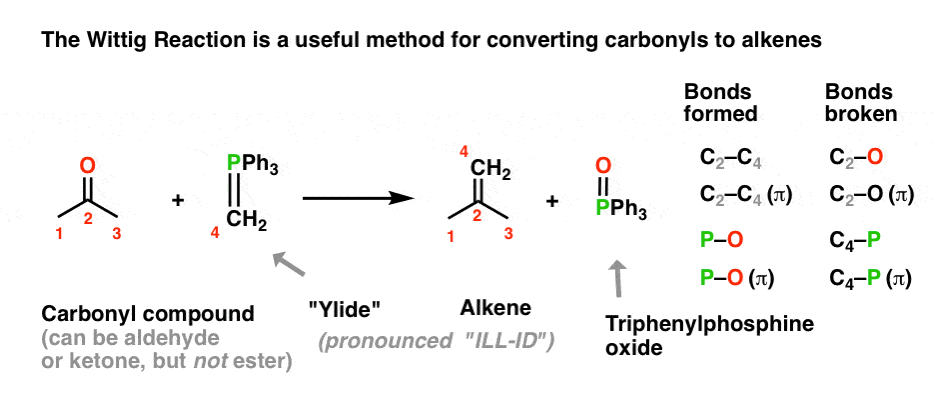
Is sulfur ylides, (quiz id 0040), should not the sulfur bear the negative charge, being larger in size and slightly more electronegative than carbon?
Would PH3 or PCl3 work here inplace of PPh3?
Hi ! I am confused by the quiz about the acetal protecting group, so the H3O+ only removed the mask of aldehyde group? Would the H3O+ do the acid catalyzed hydration on the alkenes outside the benzene or they are stable because of the conjugation with benzene so they won’t react with H3O+? Thanks
Yes, the acetal is fairly easily removed by aqueous acid. I realize when you’re learning organic chemistry, textbooks can be fairly careless about H3O+. It can be used for hydration of alkenes, hydrolysis of acetals, or simple workup of a basic solution (e.g. Grignard reaction), but you’re not really given any gauge on the relative reactivity of any of these processes.
In practice it takes a pretty concentrated acid to hydrate the alkene, whereas a dimethyl acetal is readily hydrolyzed with H3O+. I suppose for a situation like this it might make it better to say, “mild acid?”. If it were “concentrated H2SO4, H2O” then I would see hydration as a significant process.
Hi, love the explanations but would’ve been a tad nice to see the mechanism of the intramolecular wittig reaction:) Tried it out anyways, but can’t really check if it’s right – have tried google, but yeah, just wasn’t sure in what order the bromid would fall off and such.
Noted. Thanks for the suggestion.
Hello James! Does 3° alkyl halide also show Wittig reaction.
No, because it isn’t possible to form the ylide if there are no C-H bonds on the carbon attached to the P.
Hello! What will happen when an ester reacts with Ylide.
Ylides don’t undergo Wittig-style reactions with esters. If anything happens at all, it would be addition-elimination. If you want a Wittig-style olefination of an ester, you could use something like the Tebbe reagent.
Generally esters don’t react with ylides. To form a new =CH2 bond with the C=O of the ester you’d have to use something like the Tebbe reagent.
James I’ve got a question,
Could you use the Wittig reagent to attack a metal-oxo bond and replace the oxygen with a carbene?
That’s a good question. I usually see the other way around – a carbene reacting with a heteroatom to give an ylide.
There might be a pathway there. It would be a good research project.
Please mention drawbacks of this reaction.
Hello!
I was wondering how electron withdrawing groups, sterics, and aldehyde/ketone on a benzene ring affect the rate of a Wittig reaction. For example, if you have a benzene ring with an aldehyde and nitro group in para positions versus a benzene ring with a methyl ketone and two nitro groups in the ortho and para positions, which do you think would react faster in a Wittig reaction with Ph3P=CH2?
Hard to predict your specific example since you’re changing multiple interlinked variables. Aldehydes are more reactive than ketones, and electron-poor carbonyls (such as aromatic aldehydes with p-nitro groups) are more reactive than electron-rich carbonyls.
Hi James,
I’ve performed the Wittig reaction a few times in the lab and I’ve used potassium tert-butoxide as a base. This is interesting considering the pKa of PPh3PCH3 is around 35 while the pka of the conjugate acid of potassium tert-butoxide is around 17 which is obviously significantly weaker. Any explanation on how the reaction still works (note I’ve always gotten a decent yield of around 75-80% and the reaction has proceeded in around 1-2 hours)?
Best,
Pat
Hi Pat – I’m not seeing the pKa of Ph3P-CH3(+) as 35 – I see it as 22.4, at least according to the Evans pKa table (page 5).
Not sure what your solvent is, but KOtBu will also be more basic in non-protic media.
http://evans.rc.fas.harvard.edu/pdf/evans_pKa_table.pdf
The original study of acidities of phosphonium ylides is here: Bordwell, F. G.; Zhang, X.-M. J. Am. Chem. Soc. 1994, 116, 968–972.
Hi! I had a question regarding the formation of the ylide. The PPh3 group appears to be very sterically hindered due to the presence of 3 benzene rings attached to the central phosphorus. Does that have any effect on the initial SN2 step?
Thanks!
Good question. Definitely not an issue with primary alkyl halides. It helps that the C-P bond is relatively long. 1.84 A. Can be complicated with secondary alkyl halides. The main issue is that you’re going to get crappy E/Z selectivity in the resulting alkene. One situation where it’s been OK is on the position adjacent to a carbonyl. https://onlinelibrary.wiley.com/doi/abs/10.1002/%28SICI%291521-3773%2819991216%2938%3A24%3C3662%3A%3AAID-ANIE3662%3E3.0.CO%3B2-1
Thanks for great explanation